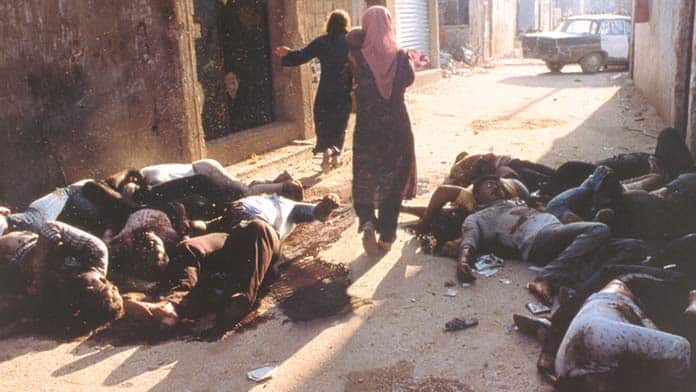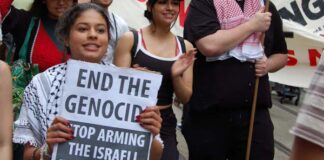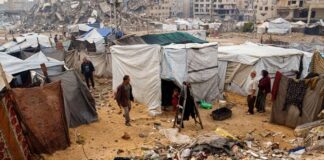The massacre at the Sabra and Shatila refugee camps in Lebanon was one of Israel’s most shocking war crimes against the Palestinians, writes Ella Haber
On 16 September 1982, four months after Israel invaded Lebanon, the far-right Lebanese Phalange militia stormed the two densely populated refugee camps in Beirut. Israeli soldiers were ordered to allow them into the camps and to seal the exits so no one could escape.
Israel’s Defence Minister Ariel Sharon and a team of senior officers in the Israeli Defence Force (IDF) approved the decision. IDF chief of staff Raphael Eitan had even flown directly to the Phalangists’ headquarters the previous morning to instruct them to carry out the attack.
The first unit of 150 Phalangists entered the camps at 6pm, while Israeli forces fired illuminating flares into the night sky so the killing could continue through the night. For 38 hours, a barbaric massacre unfolded, claiming the lives of 3000 to 3500 mostly Palestinian civilians—men, women, children, and the elderly, along with some Lebanese civilians seeking refuge from Israel’s shelling of South Lebanon.
Robert Fisk, one of the first journalists on the scene, wrote that: “[The dead] were everywhere, in the roads, in the laneways, in backyards and broken rooms … women, young men, babies and grandparents—lying together in lazy and terrible profusion where they had been knifed or machine-gunned to death.”
On the morning of 18 September, under pressure from US diplomats following growing publicity about the massacre, the Israeli Army ordered the Phalange to halt their operation. Israel then supplied bulldozers to dig mass graves that would hide the horrifying evidence.
The United Nations General Assembly declared the Sabra and Shatila massacre to be an act of genocide, while the United States and Israel stood alone in refusing to condemn it.
The Kahan commission, an Israeli government inquiry, provided mountains of evidence that the Israeli command were aware that a massacre was taking place, and allowed the Phalangists to proceed. On the second day, after hearing details of deaths of women and children, Defence Minister Ariel Sharon claimed they were “terrorists” who “need mopping up”, saying “if you don’t want the Lebanese to kill them, we will kill them”.
What was the motivation for such a brutal attack on civilians? Sabra and Shatila had been two of the main training camps and operation bases for the resistance fighters of the Palestine Liberation Organisation (PLO).
The last Palestinian fighters had been evacuated from Beirut under a ceasefire agreement the previous month, and the unarmed Palestinian civilians of the camps posed no military threat. But as Israeli journalists Schiff and Ya’ari wrote in their book Israel’s Lebanon War, the Israeli government wanted “to eradicate every last trace of the PLO in Beirut”.
The PLO had its strongest base of support among the Palestinian residents of the camps, many of them refugees expelled from their homes during the Nakba in 1947. Unleashing terror on these unarmed Palestinian civilians was Israel’s way of sending a message that any support for the PLO would be punished with brutal force.
Lebanon war
Israel invaded Lebanon on 6 June 1982, aiming to drive the PLO out of the country and end to its ability to launch attacks on Israel over the border. They proceeded with a full-scale military offensive throughout the country, laying siege to the PLO’s positions in West Beirut with relentless bombing.
The invasion came during the Lebanese civil war that had begun in 1975, in which Israel supported Christian Maronite forces including the Phalange.
Although the invasion was launched following the attempted assassination of Israeli ambassador Shlomo Argov, Israel had planned it for some time.
Ariel Sharon had gained the support of the US Defence Secretary in the early months of 1982 for action in Lebanon, and secured record-level surges of military supplies and weapons from the Pentagon direct to IDF bases near the Lebanese border.
The Israeli paper Ha’aretz wrote in March 1982 that, “Behind the official excuse of ‘we shall not tolerate shelling or terrorist reactions’ lies a strategic view, which holds that the physical annihilation of the PLO has to be achieved. That is, not only must its fingers and hands in the West Bank be amputated (as is now being done with an iron fist), but its heart and head in Beirut must be dealt with.”
There were at least 19,000 killed and 30,000 wounded in the invasion. In South Lebanon, Israeli jets flew numerous missions against PLO targets. One such attack used a US-supplied “smart bomb” which destroyed an entire building and killed 100 people in a failed effort to assassinate PLO leader Yasser Arafat.
Sharon met several times with Bashir Gemayel, the leader of the right-wing Christian-based Lebanese Forces, a political party that ran the Phalange militia, to agitate for a united military offensive on the Palestinian camps.
The Lebanese Forces accepted a great deal of political and military support from the IDF. On 23 August, Gemayel was elected President of Lebanon with the assistance of Israel’s intelligence agency Mossad.
The IDF began to co-ordinate their efforts with the Phalange on the basis of a common interest: to crush the Palestinian resistance movement and maintain the integrity of the Christian Maronite-dominated ruling class in Lebanon.
Palestinian camps were razed to the ground by Lebanese troops under Israeli command—populations were displaced, and men suspected of fighting for the Palestinian cause were imprisoned in internment camps.
For over two months PLO fighters held out in the capital Beirut, but as they became isolated, the PLO agreed to leave the country under an American-brokered ceasefire deal that involved sending in a multinational force to oversee their evacuation.
Israel broke the ceasefire on 14 September, using the assassination of Gemayel to unleash them on the camps of West Beirut. The peacekeeping force withdrew as soon as the PLO fighters were evacuated, and Palestinian civilians were left to the mercy of the new Phalangist-Israeli alliance with a licence to kill.
PLO strategy
The PLO was formed in 1964 as a political and armed resistance force dedicated to the liberation of Palestine.
Fatah—a left-wing Palestinian nationalist party—gained tremendous support among Palestinians across the refugee camps in Jordan, Syria and Lebanon after it launched a guerrilla struggle under the leadership of Arafat.
Fatah became the largest faction in the PLO and the dominant political force in the Palestinian resistance movement. However, as Arab leaders grew anxious over the movement’s potential to destabilise the region, Fatah made promises to not interfere in the domestic affairs of Arab regimes.
Fatah saw the Palestinian armed struggle as a lever to pressure the Arab rulers of states such as Egypt, Syria, Iraq and Jordan to take up the struggle for a Palestinian state—and in doing so, ignored the revolutionary potential of Arab workers and peasants.
But the approach had a fatal flaw—the Arab regimes had increasingly made their peace with Western imperialism’s domination of the region.
Wherever the militancy of the PLO was perceived as a threat, it would be ruthlessly suppressed by the Arab regimes with the financial backing of Israel and the US. When Fatah’s strength in Jordan became a threat to the regime of King Hussein in 1970, the Jordanian ruling class launched an Israel-backed military offensive on the PLO called “Black September” that claimed thousands of Palestinian lives.
Despite the promises of support from neighbouring Arab regimes, Syrian and Iraqi forces stood aside and the whole Arab world looked on.
The PLO established a new base in Lebanon in 1971, with an even more rigid insistence that the movement must respect Arab rulers.
The rapid development of the Gulf oil economy in the region had produced an increasingly impoverished, urbanised working class in Lebanon—and the 200,000 Palestinian workers living in the camps made up 8 per cent of the population.
The Palestinian resistance movement had begun to radicalise workers in Lebanon and, as the country slid towards crisis and repeated mass strikes in 1973, a military front of secular leftist and pan-Arabist groups sought to challenge the Christian Maronite-dominated ruling class in Lebanon.
The struggle for Palestinian liberation threatened to merge with struggle of Arab workers against their rulers. Fatah, however, instructed all Palestinian forces to abstain from activity in domestic affairs.
Civil war erupted in 1975 and Maronite Christian militias trained and armed by the IDF—including the Phalangists—brutally attacked the Palestinian populations in the Beirut camps. Syria sent in 40,000 troops to crush the popular resistance. Once again, the PLO’s refusal to challenge the Arab regimes led to their defeat.
Lessons
Israel’s 1982 invasion of Lebanon shows that the struggle for Palestinian liberation can succeed only as part of a struggle against imperialism’s control of the whole Middle East.
Arab rulers have continually betrayed the Palestinian cause because their wealth and power relies on collaboration with the US and Israel.
But among ordinary people across the region, Palestinians have massive popular support. In the 2020 Arab Opinion Index, three-quarters of the population across the Arab world agreed that the Palestinian cause concerns all Arabs.
Yet regimes like Egypt and Jordan have economic agreements and co-ordinate militarily with Israel to suppress both Palestinian resistance and their own populations.
As we saw in the Arab revolutions in 2011, mass struggle from below has the potential to topple regimes and spread a wave of revolution across the region.
The liberation of Palestine from the brutal Zionist occupation can succeed only as part of a broader struggle for the liberation of workers and peasants across the Arab world, against both their own corrupt rulers and the imperialist powers that back them.






